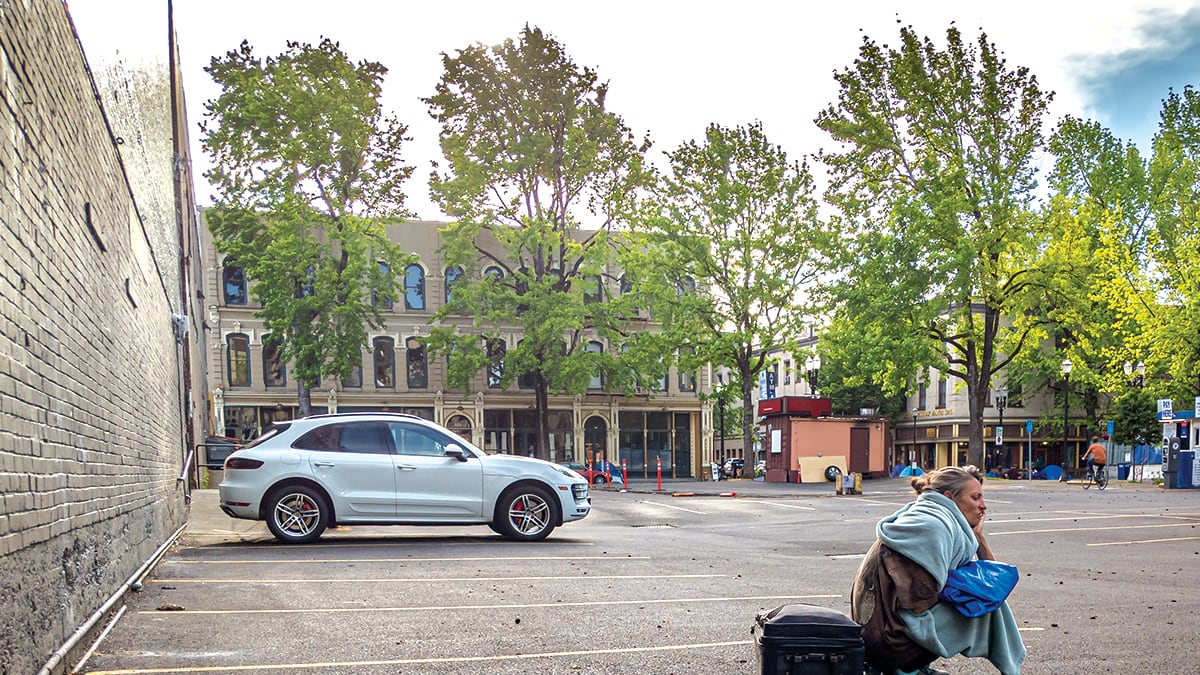Scott Kerman was helping serve breakfast last week to homeless Portlanders at Blanchet House in Old Town, where he serves as executive director.
A woman lingered at the coffee window, talking to herself and ignoring volunteers. A man behind her in line shouted at her to move and, Kerman says, “she just snapped.”
She rushed toward the man aggressively, cursing and yelling. Kerman ran out from behind the plastic partition, bringing the man a cup of coffee.
That defused the encounter. But conflict is increasing at Blanchet.
No one at the nonprofit is equipped to deescalate such situations, except its one peer support specialist. And one is not enough, Kerman says.
“I need more of this person,” says Kerman, whose team serves 1,500 meals a day to the homeless. “We need this person at all of our meals, six days a week.”
That person is Jenn Coon, who used to be homeless herself. She says the number of people visibly experiencing symptoms of psychosis during mealtimes around Blanchet House has grown. And the increase is steepest among women.
“There’s more women that are hearing voices, having psychotic moments, and having extreme anxiety,” Coon says. “There are times when I feel pretty helpless. A woman came up to me the other day and said, ‘My mom told me to punch you in the fucking face.’”
Old Town hosts the greatest concentration of homeless Portlanders in the city. Kerman and other providers say women are having psychotic episodes in Old Town at an unprecedented rate. The nonprofits don’t want to call police on homeless people in distress, but they’re also not trained to soothe the conflicts themselves.
So half a dozen service providers in Old Town are asking for money to hire help.
Kerman’s idea: a mobile team of peer support specialists trained to deescalate crises and rotate between providers throughout the day. “If we don’t address this, it’s only going to worsen,” Kerman warns. “I don’t want to be melodramatic and say it threatens our ability to serve, but it can certainly change the landscape in ways we don’t want to imagine.”
A lot of dollars are aimed at the homeless crisis.
Multnomah County is flush with cash thanks to federal bailout money and a $2.4 billion homeless services measure Metro voters passed last year, $52 million of which is available to the county in the first year. The money is mostly going toward permanent supportive housing, with smaller portions going to emergency and alternative shelters and behavioral health services.
And the city of Portland has pledged to use around $20 million of its available federal relief dollars for six “safe rest villages” this year.
Kerman and his Old Town colleagues want some of that money to confront immediate needs.
They say the spike in psychotic behavior threatens their ability to provide services. Kerman says Blanchet House considers temporarily halting serving one of its three daily meals at least four or five times a week because of someone’s behavior.
And some providers say the problem seems worse among women.
It’s not easy to pin down exactly why, but increased reliance on hard drugs like methamphetamine and opioids as coping mechanisms is likely part of it, says Erin Porter of the Oregon Idaho High Intensity Drug Trafficking Area: “With the housing crisis and COVID-19, use of illegal substances has increased drastically.” She says a primary reason homeless people use meth is to stay awake in case someone tries to commit a crime against them.
Multnomah County health officials say that 106 fatal meth overdoses occurred between January and June this year, compared to 82 in the same time frame last year. However, an increase in fentanyl-laced pills contributed to that spike. (WW previously examined the rise in meth-induced psychosis last year: “Over-Amped,” Feb. 26, 2020).
Though county officials say it’s unclear whether meth use increased in the past year, it’s been “incredibly cheap and strong” for the past few years, says Kelsi Junge, a supervisor with the county’s harm reduction program.
Increasingly compounding traumas contribute to mental distress too, says Liz Starke, development director at Rose Haven, another homeless services nonprofit, in the Alphabet District. Such traumas include inescapable heat waves and social services closing their indoor spaces due to the pandemic.
“Degradation on mental health has been really visible,” she says. And being a woman on the streets, Starke says, adds another layer of potential violence and vulnerability.
Coon and other providers hesitate to call 911 on people experiencing mental health crises.
“That’s the last thing I want to do. I’m not trying to add anxiety to the situation by bringing police,” Coon says. “We also don’t want to be labeled a snitch on the streets.”
Coon says she sometimes calls the county’s mental health line, but adds it takes hours for help to arrive: “By the time they come, the person has completely moved on.”
The plan has parallels to Portland Street Response, a city program that takes mental health and homelessness calls in the Lents neighborhood but has yet to be expanded citywide.
Darlene Urban Garrett, a board member of the Downtown Neighborhood Association, says she supports the idea of mobile crisis teams, but wants such services made available on a larger scale, especially if they’re publicly funded.
“If they’re going after more public dollars to make this happen, then I’d like to see more coordination,” Urban Garrett says. “But to have something created for Blanchet House and not have it be able to be utilized by everyone else, that’s what bothers me. Because we’re all sitting in silos.”
Service providers, chronically hurting for cash, want public help because their resources and staffing are already stretched thin.
Kerman has broached the idea with half a dozen homeless outreach agencies and nonprofits downtown, including Rose Haven, Sisters of the Road, the Portland Rescue Mission and the Maybell Center, because neither Blanchet House nor other providers have the cash on hand to fund it.
And he’s approached an operation with social and financial clout: Central City Concern, by far the biggest social services provider in Old Town.
Juliana Wallace, Central City’s senior director of mental health, says there’s a deep gap in options for handling mental health crises downtown, and the approach would be peer to peer, not authority to peer.
“It would be pre-crisis work. The time you spend engaging, listening to people, hearing, supporting them, and looking for signs that they’re having a difficult time—that’s part of the gap,” says Wallace. “[The idea] is that we support people before they become so escalated that we’re in the normal city response of do we call Project Respond or 911 or the police?”
Wallace says funding would most likely be a mix of public and private dollars.
Seraphie Allen, Portland Mayor Ted Wheeler’s housing adviser, says city commissioners’ offices discussed adding crisis workers during preparation of the city budget in the spring. But she says the offices agreed the issue was the county’s responsibility.
So Wheeler’s office informally shopped the idea with the county to fund crisis workers for Old Town. No dice. “We proposed that, and it didn’t happen,” Allen says.
No written plan or request was ever formally made.
Multnomah County Chair Deborah Kafoury says the county is making other significant investments to address the problem: $2.5 million toward creating three more street outreach teams and expanding existing ones, as well as beefing up behavioral health staff at shelters.
But Kerman and other providers want to strategically place specialists where mental health crises happen and escalate—he compares it to placing fire extinguishers in buildings.
“We know that the community wants additional services, and we welcome a conversation with Scott and his partners about what that might look like,” Kafoury says.
Meanwhile, the behavioral health workforce has experienced a mass exodus since the pandemic started, making it more difficult to hire staff to fill such positions.
Kerman says he’s heard Old Town referred to as an “open-air psychiatric ward.”
“In a lot of ways, that’s not an unfair characterization,” he says, adding that homeless people who can camp in places other than Old Town do. “Who’s left are kind of the most fragile, the most chronically homeless, the most addicted or struggling with severe mental [illness].”

